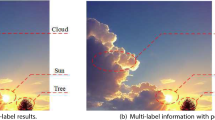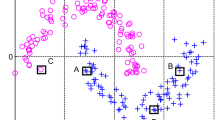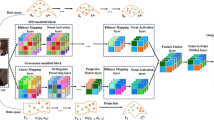Abstract
As an efficient and intuitive dimension reduction algorithm, non-negative matrix factorization (NMF) has been widely employed in various fields. However, the existing NMF based methods have two disadvantages. Firstly, it treats each sample equally without considering the noise problem. Secondly, it does not restrict the coefficient matrix. Therefore, this paper proposes a novel weighted NMF algorithm based on adaptive robust local sparse graph (WNMF-ARLS), which includes the following superiorities compared with the other NMF-based algorithms: 1) The proposed method introduces a weighting regularization term, which distributes smaller weights to outliers and noise, and allocates larger weights to clean data. 2) Our method constructs a sparse local constraint graph to discover the data’s potential manifold structure. 3) Unlike most NMF algorithms based on graph regularization, in which the graphs remain unchanged and are pre-defined during the NMF process, the proposed method introduces sparse constraints and local constraints into the unified framework to adaptively construct the optimization graph. Lots of image clustering experiments are provided to illustrate the effectiveness and superiority of the proposed WNMF-ARLS algorithm. Experimental results also show that the clustering performance of the proposed method is significantly better than that of other comparison algorithms.







Similar content being viewed by others
Data Availability
The data used in this paper are all from public datasets, and they can be easily obtained for scientific research.
References
Bai Y, Wang C, Lou YH et al (2021) Hierarchical connectivity-centered clustering for unsupervised domain adaptation on person re-identification. IEEE Trans Image Process 30:6715–6729
Boyd S, Parikh N, Chu E et al (2011) Distributed optimization and statistical learning via the alternating direction method of multipliers. Found Trends Mach Learn 3(1):1–122
Cai D, He X, Han J, Huang TS (2011) Graph Regularized Nonnegative Matrix Factorization for Data Representation. IEEE Trans Pattern Anal Mach Intell 33(8):1548–1560
Cheng B, Yang J, Yan S et al (2010) Learning With L1-Graph for Image Analysis. IEEE Trans Image Process 19(4):858–866
Dai XG, Zhang KK, Li JT et al (2021) Robust semi-supervised non-negative matrix factorization for binary subspace learning. Complex Intell Syst. https://doi.org/10.1007/s40747-021-00285-1
Ding C, Kong D (2012) Nonnegative matrix factorization using a robust error function. IEEE International Conference on Acoustics, Speech and Signal Processing (ICASSP), Kyoto
Gangodkar D, Chandran SN (2021) A novel image retrieval technique based on semi supervised clustering. Multimed Tools Appl 80(28–29):35741–35769
Hamza AB, Brady DJ (2006) Reconstruction of reflectance spectra using robust nonnegative matrix factorization. IEEE Trans Signal Process 54(9):3637–3642
Han C, Shao G, Hao Y et al (2013) Non-Negative Matrix Factorization based on Locally Linear Embedding. 11th International Symposium on Operations Research and its Applications in Engineering, Technology and Management 2013 (ISORA 2013), Huangshan
He X, Wang Q, Li X (2019) Robust adaptive graph regularized non-negative matrix factorization. IEEE Access 7:83101–83110
Hu WB, Chen CA, Ye FH et al (2021) Learning deep discriminative representations with pseudo supervision for image clustering. Inf Sci 568:199–215
Hu SZ, Yan XQ, Ye YD (2021) Multi-task image clustering through correlation propagation. IEEE Trans Knowl Data Eng 33(3):1113–1127
Huang J, Nie F, Huang H et al (2014) Robust manifold nonnegative matrix factorization. ACM Trans Knowl Discov Data 8(3):1–21
Huang D, Wang C, Lai J (2018) Locally Weighted Ensemble Clustering. IEEE Trans Cybern 48(5):1460–1473
Huang S, Xu Z, Wang F (2017) Nonnegative matrix factorization with adaptive neighbors. In Proceedings of the 2017 International Joint Conference on Neural Networks (IJCNN), Anchorage, pp 486–493
Kanungo T, Mount DM, Netanyahu NS et al (2002) An efficient k-means clustering algorithm: Analysis and implementation. IEEE Trans Pattern Anal Mach Intell 24(7):881–892
Kong D, Ding C, Huang H (2011) Robust nonnegative matrix factorization using L21-norm. Proceedings of the 20th ACM Conference on Information and Knowledge Management, CIKM 2011, Glasgow, United Kingdom
Lee DD, Seung HS (2001) Algorithms for non-negative matrix factorization. In: Advances in Neural Information Processing Systems (NIPS), Cambridge, pp 556–562
Li Z, Tang J, He X (2018) Robust Structured Nonnegative Matrix Factorization for Image Representation. IEEE Trans Neural Netw Learn Syst 29(5):1947–1960
Li XL, Yu JL, Zhao PF (2020) Manifold ranking graph regularization non-negative matrix factorization with global and local structures. Pattern Anal Appl 23(2):967–974
Liu G, Lin Z, Yan S et al (2013) Robust Recovery of Subspace Structures by Low-Rank Representation. IEEE Trans Pattern Anal Mach Intell 35(1):171–184
Liu Z, Yue Lu, Lai Z et al (2021) Robust sparse low-rank embedding for image reduction. Appl Soft Comput 113:107907
Qilong Z, Ganlin S, Xiusheng D (2008) Weighted Support Vector Machine Based Clustering Vector. 2008 International Conference on Computer Science and Software Engineering, Hubei
Wen J, Han N, Fang X et al (2019) Low-Rank Preserving Projection Via Graph Regularized Reconstruction. IEEE Trans Cybern 49(4):1279–1291
Wenpeng Lu, Zhang Y, Wang S et al (2021) Concept Representation by Learning Explicit and Implicit Concept Couplings. IEEE Intell Syst 36(1):6–15
Xie J, Jiang S (2010) A Simple and Fast Algorithm for Global K-means Clustering. 2010 Second International Workshop on Education Technology and Computer Science, Wuhan
Yang Z, Zhang Y, Xiang Y et al (2020) Non-Negative Matrix Factorization With Dual Constraints for Image Clustering. IEEE Trans Syst Man Cybern Syst 50(7):2524–2533
Yin M, Gao J, Lin Z (2016) Laplacian Regularized Low-Rank Representation and Its Applications. IEEE Trans Pattern Anal Mach Intell 38(3):504–517
Zhang L, Liu ZH, Pu JX et al (2020) Adaptive Graph Regularized Nonnegative Matrix Factorization for Data Representation. Appl Intell 50:438–447
Zhang Q, Miao Z (2017) Subspace Clustering via Sparse Graph Regularization. 2017 4th IAPR Asian Conference on Pattern Recognition (ACPR), Nanjing
Zhu F, Gao J, Yang J et al (2022) Neighborhood linear discriminant analysis. Pattern Recogn 123:108422
Zhu F, Ning Y, Chen X et al (2021) On removing potential redundant constraints for SVOR learning. Appl Soft Comput 102:106941
Acknowledgements
This work was partly supported by NSFC of China (U1504610, 61971339, 61471161), the Scientific and Technological Innovation Team of Colleges and Universities in Henan Province (20IRTSTHN018), the Natural Science Foundations of Henan Province (202300410148), Key scientific research projects in Colleges and Universities (22A120006).
Author information
Authors and Affiliations
Corresponding author
Ethics declarations
Conflicts of Interest
The authors declare that there are no conflicts of interest regarding the publication of this paper.
Additional information
Publisher's Note
Springer Nature remains neutral with regard to jurisdictional claims in published maps and institutional affiliations.
Rights and permissions
Springer Nature or its licensor (e.g. a society or other partner) holds exclusive rights to this article under a publishing agreement with the author(s) or other rightsholder(s); author self-archiving of the accepted manuscript version of this article is solely governed by the terms of such publishing agreement and applicable law.
About this article
Cite this article
Zhang, G., Chen, J., Lu, W. et al. Weighted non-negative matrix factorization based on adaptive robust local sparse graph. Multimed Tools Appl 82, 46313–46330 (2023). https://doi.org/10.1007/s11042-023-15629-x
Received:
Revised:
Accepted:
Published:
Issue Date:
DOI: https://doi.org/10.1007/s11042-023-15629-x




